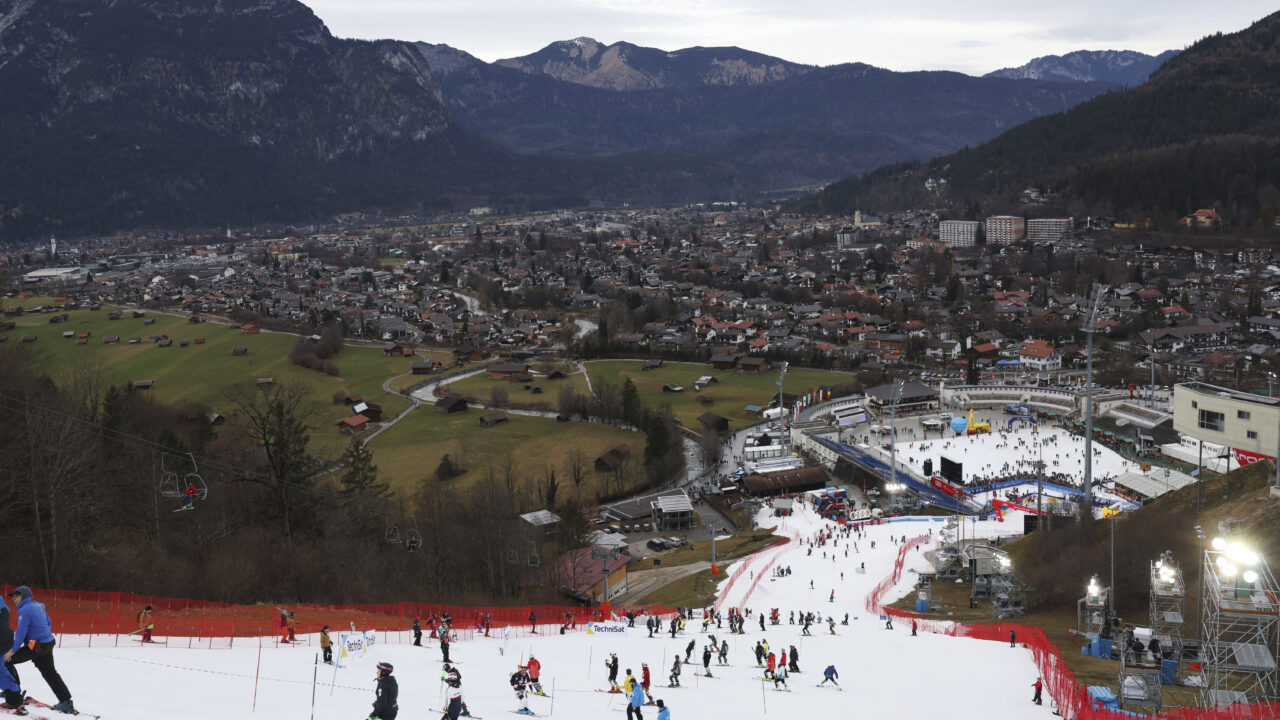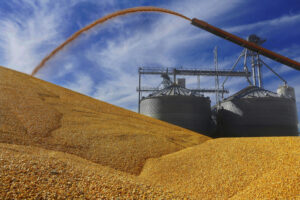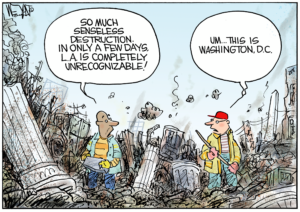Alpine Snow Cover Decline Worst in 600 Years
Millions of people depend on meltwater from the Alps snowpack. Sparse snowfall and unseasonably warm winter weather in Europe's central mountains are allowing grass to blanket hillsides across the region. Photo: Alessandro Trovati / AP.
Sparse snowfall and unseasonably warm winter weather in Europe's central mountains are allowing grass to blanket hillsides across the region. Photo: Alessandro Trovati / AP.
The duration of snow cover in the Alps is now 36 days shorter than the long-term average—an “unprecedented” decline over the past 600 years—according to recent research.
The paper, published in Nature Climate Change, uses ring-width records from juniper shrubs to assess snow cover duration in the Alps over the past six centuries.
The study is part of the established research field of “proxy” data, which uses indirect records of climate imprinted on different parts of the biosphere to determine how the climate has changed over thousands of years.
The findings are significant for the millions of people who depend on meltwater from the Alps snowpack every year for “agricultural, industrial and domestic purposes”, as well as “winter tourism and related recreation activities”, the authors write.
A researcher not involved in the study tells Carbon Brief that the study is “significant”, because “we now have, basically for the first time, an annually resolved proxy with a clear response to winter conditions”
The Alps are Europe’s largest mountain range, stretching from France to Slovenia. They provide as much as 90% of the water to lowland Europe, earning them the moniker “the water towers of Europe”.
According to the Intergovernmental Panel on Climate Change (IPCC), mountain areas with seasonal snow cover are “essential” for animal foraging, relief from climate stress, food caching and nesting grounds. Loss of snowy habitats globally has already driven decreasing population growth for some mountain animals, including frogs, rodents and small carnivores, it adds.
Snow preserves soil conditions during the cold winter months, thanks to its insulating properties. “Significant decreases in snow cover” will increase the susceptibility of agricultural crops and perennial species to the adverse effects of freezing temperatures, according to the IPCC.
Snow cover also reduces local temperatures, as its bright surface reflects light and heat from the sun— a process known as the albedo effect.
The new study finds a solution in the form of growth rings on juniper shrubs instead of trees. These can provide a good proxy for winter snow cover, the researchers say.
Lead author Prof Marco Carrer, a professor at the department of land environment agriculture and forestry, from the University of Padova, tells Carbon Brief:
Snow cover is absolutely important for the energy balance of the atmosphere. For the biosphere, there are a lot of plant and animal species—especially in the mountain area—that really need the snow cover because they are adapted to being in the Alps.
The Alps are also one of the most popular tourism destinations in the world, attracting 120m visitors every year for activities including skiing, snowboarding, hiking and cycling. The lack of winter snow has made international news in recent years, including in 2023 when Alpine resorts were driven to bring in snow by helicopter and offer “alternative entertainment”—such as “hiking with goats“—the New York Times reported.
Seasonal snow cover in the Alps—measured between November and May—has seen an 8.4% decline per decade between 1971 and 2019, according to past research. At the same time, snow cover duration has dropped by 5.6% per decade.
To put this recent decline into its historical context, the authors say “it is crucial to have information about long-term reliable observations or proxy series of snowpack extent and duration.”
Scientists use “proxies” as a source of climate information going back long before direct measurements were collected. For example, scientists can analyse the width of tree rings to determine temperature and rainfall levels year on year—as rings are typically wider in warm, wet years where the tree is getting sufficient sunshine and rainfall to support growth.
The Alps have one of the longest traditions of climate data collection, with air pressure, temperature and precipitation series extending dating back to the mid-18th century, according to the study. Experts have combined this instrumental data with proxy climate data derived from tree rings to produce a record of the local climate over “exceptionally long periods”, the paper says.
However, in contrast, local measurements of snowpack “often extend back only a few decades”, the study says. In addition, “the long resting period during the cold season, joined with the mostly negligible moisture-limiting conditions of the Alps, prevents adopting tree rings as an effective proxy to reconstruct snow conditions”, the researchers say.
The new study finds a solution in the form of growth rings on juniper shrubs instead of trees. These can provide a good proxy for winter snow cover, the researchers say.
While upright growing trees do not grow in winter, the flat-growing juniper shrub – a common shrub that can live for hundreds of years and grows at high altitudes across the northern hemisphere – is known for its drought and frost resistant properties and a year-round growth-cycle linked less to atmospheric conditions.
Prof Fabio Gennaretti, professor of forest science at the University of Quebec, who was not involved in the study, tells Carbon Brief:
It is normally difficult to analyse such a species due to its prostrated growth form and presence of missing tree-rings (undetectable rings). However, the authors give a convincing demonstration of the robustness of the chronology and of the stability of the statistics with snow cover duration.
By assembling ring growth data from 572 juniper shrubs, the researchers were able to reconstruct the year-to-year snow cover duration in the Alps over the past 600 years.
The researchers compared their results with instrumental data records for snow cover duration collected over the past three decades, and snow cover duration modelling based on available temperature and precipitation records dating back to 1834.
The plot below shows instrumental data (red), modelled data (blue) and the proxy reconstruction data (black) from the Alps.
The authors found a “remarkably strong and stable” consistency between their ring-width reconstruction and model results.
The study finds that snow cover duration began a longer-term decrease around the end of the 19th century.
They identified episodes over the past 600 years with notably long and short snow cover duration. Some of the longest include the 1440-1460 and 1780-1800 periods, while some of the shortest occur in the low-snowy decades of 1940-1960.
The study finds that snow cover duration began a longer-term decrease around the end of the 19th century. It adds that the first two decades of this century saw an “unprecedented” average snow cover duration of just 215 days – 36 days fewer than the long-term average over the past 600 years.
Prof Markus Stoffel, a professor in the department of Earth and environmental sciences at the University of Geneva, who was not involved in the study, tells Carbon Brief:
The study is a significant piece of research as we now have, basically for the first time, an annually resolved proxy with a clear response to winter conditions.
However, he warns:
As precipitation and snow vary substantially in space and time, the findings are certainly very valid for the case-study region. Yet, drawing conclusions for the wider alpine space seems difficult.”
As such a popular destination for skiing, the results have serious implications for the “absolutely fundamental” winter tourism in the Alps, lead author Carrer tells Carbon Brief. He says:
In the last few years, and year after year, and especially the last couple of years, they are really experiencing a lot of problems.
Let’s say back in time, when I was younger, I remember we used to ski below 1,500 metres of elevation and this was never a problem. And now let’s say it has started to be a real problem to maintain this key area below, let’s say 1,800 metres of elevation, because of the [high] temperature. And so for the tourists, this is really a direct effect for them.
Your support is crucial…With an uncertain future and a new administration casting doubt on press freedoms, the danger is clear: The truth is at risk.
Now is the time to give. Your tax-deductible support allows us to dig deeper, delivering fearless investigative reporting and analysis that exposes what’s really happening — without compromise.
Stand with our courageous journalists. Donate today to protect a free press, uphold democracy and unearth untold stories.





You need to be a supporter to comment.
There are currently no responses to this article.
Be the first to respond.